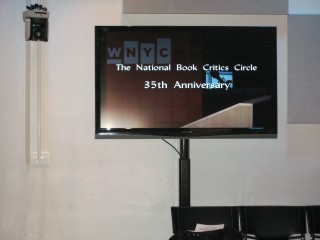Reamy Jansen is a past, two-term Vice President for Membership. He is a Professor of English and Humanities at Rockland Community College (SUNY) and an Adjunct Professor of Media Studies at Fordham University’s College at Lincoln Center. For the past fifteen years, he has been a Contributing Editor to The Bloomsbury Review of Books and also edits the magazine’s short essay section, “The Out of Bounds Essay.” He is also Creative Nonfiction Editor for The Hamilton Stone Review. His essays and poems have appeared in a variety of journals and have been many times nominated for the Pushcart Prize.His volume of linked essays about fathers and sons, generations and mortality, Available Light, will be coming out in May from Hamilton Stone Editions.He offers “On Reading—A History of Sorts,” as part of the NBCC’s 35th anniversary, celebrated September 12 at WNYC’s Jerome L. Greene Performance Space.
Thesis One: Critics must be ferocious readers. I offer myself into evidence.
Days at my college often begin with a discussion of books from the very moment I exit my beat up Toyota, always green with books. One morning, for example, I was stopped by my 6’4” colleague, Oden Oak, who told me that he had been reading through the recommendations provided in Clifton Fadiman’s Lifetime Reading Plan. Over the years, Oden had gone from Herodotus, Aeschylus, and Virgil, through Shakespeare, Pope, and Wordsworth, on to Joyce, Woolf, and Fitzgerald.
Now, however, Oden found himself stuck at present-day fiction. As a book critic, who could I recommend? I rattled off four names, Toni Morrison’s “Song of Solomon,” A. B. Yehoshua’s “A Woman in Jerusalem,” Jose Saramago’s “The History of the Siege of Lisbon,” and David Malouf’s “Remembering Babylon.” I choose books in my own restless way, and I’ve never seen any volume of Fadiman’s. Nevertheless, I’ve had my own lifetime plan that began by exploring my parents’ rather large library—my mother’s inclusive of Poe, Hugo, Maupassant, and Capt. Marryat (an early 19th-century precursor to Patrick O’Brian). My dad’s shelves housed Keynes’ “Monetary Reform,” Essays by Macaulay and Ruskin, a complete Shakespeare—all topped off with a leather-bound, eighteen-volume series, “The Columbia Course in Literature,” which my dad bought a few years after graduating Columbia in 1925 (this was Lou Gehrig’s class). Volume 18, Modern Writers of America was wide-ranging for its day and included women such as Sarah Orne Jewett, Mary Wilkins Freeman and Edith Wharton.
My Lifetime Plan was further aided and abetted by the Modern Library volumes I began buying in ninth grade in our only book store, Norman’s Card Shoppe (my third lifetime list, in fact, was the inclusion of the Modern Library’s catalog, printed in the back, in this case, of my copy of the “Autobiography of Benvenuto Cellini” one hundred other Modern Library volumes—I checked off at least half that I needed immediately).
In homage to my now semi-demi-hemi Marxism of the 60s and 70s, I offer my own
“Theses on Fadiman,” pace “Theses on Feuerbach.”
T2: Read everything—that’s always been my global initiative.
T3: Read as much poetry as you do fiction.
T4: Favor the offbeat and the small press—And how in the world did an eighteen-year -old, suburban, semi-hemi-demi Republican wind up at college buying, instead of his textbooks, the following volumes: Alfred Jarry’s “Ubu Roi,” “The Dwarf” by Pinter, and Rimbaud’s “A Season in Hell” and “The Drunken Boat”? Go figure, as Blanchot would say.
T4: Don’t leave out translations of contemporary work.
How did these tastes come about? The short answer is Mad Magazine first and foremost carnivalizing well before Mikhail Bakhtin; the sudden appearance of foreign films, particularly Bergman and Fellini, Be-Bop and Stravinsky, along with subscriptions from my parents to The Atlantic, Scientific American, and The Saturday Review, and an accessible 35-minute ride on the Long Island Railroad into New York City. Now seems a good time to celebrate reading and the love of books in and of themselves, those things that got us into this business in the first place. Our anniversary, it seems, also turns out to be the 35th anniversary of the Snow Cone. However, of equal importance to these two achievements is that it is the 35th anniversary of The Bloomsbury Review of Books in Denver, where I have been a Contributing Editor for over fifteen years. Blooms is, as Wallace Stegner once grumbled, “The best damn book magazine in the West.” We plan to keep it that way for many years to come. Look us up.
TXI: The point is to interpret the world and to change it. Dare to know (Sapere aude).


